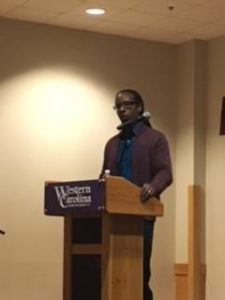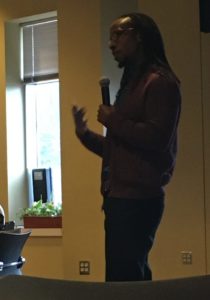In today’s society, one of the questions we consistently struggle to answer is how to finally abolish racism.
Ibram X. Kendi offers a solution that might just work.
For WCU’s Civil Discourse series, Kendi broke down racism and ways to overcome it on Wednesday, Feb. 7, in the UC Grand room.

Ibram X. Kendi defining racism. Photo by Keegan Wiggins.
First, in order to stop racism, Kendi says that it needs to be understood. He describes it as a marriage between racist ideas and racist policies.
Racist policies, according to Kendi, are the main source of racism today. While it has traditionally been taught that ignorance and hate have been the main perpetrators of racism, Kendi argues that the actual perpetrator is racist policies that were created in the 1890s that suppress racial groups.
A recent example of a racist policy that Kendi repeatedly referred to is the voter fraud legislation that was put into effect in 2016. Essentially, the legislation required voters to present identification before voting. The policy suppressed black voting.
In order to overcome racism, Kendi argues that we should switch our focus to removing these racist policies versus fighting ignorance and hate.
However, Kendi admitted that removing racist policies are difficult. His recommendation is to go into office and tackle them from inside the government rather than contacting government officials.
WCU sophomore, Alexis Gardner, introduced Kendi and was very pleased with his lecture.
“I think it went really well. It didn’t go exactly how I expected it to, it went better,” said Gardner. “You have to process his speech because it is so powerful, so much, but its impactful at the same time.”
Senior Cody Pearsall similar sentiments.
“I think it was a great informative speech,” said Pearsall. “He really digs deeper into the differences of racial ideas within the black communities.”
Prior to his presentation, I was able to talk with Kendi about his research and views on racism.
What do you want people to know about racism?
Well simply that there is nothing wrong with groups of people, and there is everything wrong with the nation’s policies. And, that’s the reason why racial inequities exist and persist not because there is something wrong or inferior with people of color but because we have discriminatory policies, some of which we know and some we don’t that we need to get rid of.
What have you learned about yourself through all of your research?
Well I’ve learned that I have a pretty big sense of humor and I think that was the way in which I was able to get through a lot of the difficult history that I was sort of researching and telling and instead of getting upset about what some people had said, I just thought that it was so ridiculous that I had to laugh.
Going off that, what are some of the challenges that you’ve faced during your research?
I think the biggest challenge in writing Stamped from the Beginning was that this book could have been 2000 pages. But we wanted it to be as accessible as possible, so we ended up having to cut it down a lot to get it into a more manageable area. It was very, very difficult doing that. It was almost like kicking babies out of your house.

Ibram X. Kendi presenting to preselected students during a lunch session. Photo by Keegan Wiggins.
How do you think being a historian has shaped the way you view racism?
Well I view it from a historical lens meaning that things happening currently I can tell through historical knowledge that it isn’t necessarily something new or that it’s new and at the same time old. So in other words, that policies, racist policies, have been taken out of the 1890s and refurbished for today or the same thing with ideas, so I’m able to make connections between the present and the past.
What do you think or hope students, staff and faculty get from your presentation?
I think that people would become more introspective. You know about their own ideas, about the policies that they may be supporting, and they would ask themselves ‘Do I hold any racist ideas? Do I support any policies that discriminate against people that cause disparity?’ And if they do, they would then seek to change that.
Towards the end of his presentation, Kendi challenged the students to find the truth in racist policies and racial ideas. He described a two step process in order to make it easier for not only students, but others as well, to recognize racist ideas.
First, to recognize racist ideas, Kendi encouraged students to ask the following question:
What is a racist idea?
Secondly, Kendi suggested students ask about a specific racial disparity. For example, why are is unemployment rates higher among blacks versus whites.
If the student or person answers consists of a negative comment like black people are lazier than white people, then they just answered with a racist idea. However, the answer Kendi wants people to recognize and answer with is job discrimination.
On that note, how do you define a racist idea?



